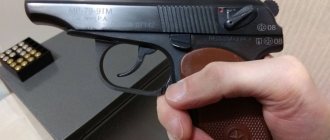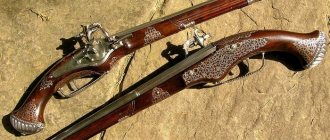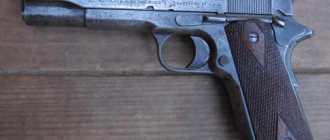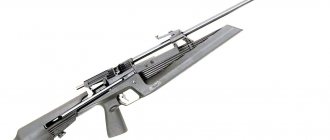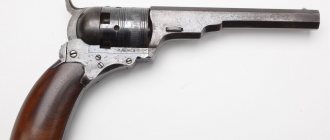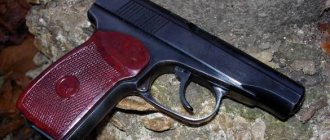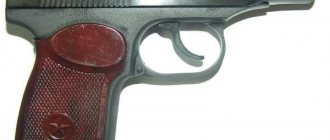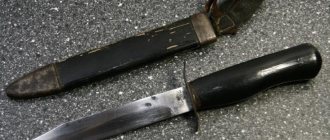Designers of handguns in all centuries have been faced with the task of making them as convenient and effective as possible. True, gunsmiths quite often understood both of these qualities in a very unique way. In pursuit of originality, they sometimes produced rather strange samples. Often the only thing they had in common with other pistols was, in fact, the ability to fire a bullet at the enemy. However, they did not always cope with this task successfully.
Below you can see both frankly unsuccessful experiments that appeared at the dawn of the development of pistols, and real masterpieces that glorified the names of their creators.
Pistol with blade
The first samples of handguns were not reliable. This fully applied to both rifles and pistols. The flints were worn down, the wicks became damp, and complex wheel locks at the most crucial moment turned out to be jammed due to dirt getting into the mechanism. Therefore, gunsmiths did not immediately begin to consider the pistol as a completely independent weapon. Until the 19th century, craftsmen strove to combine the usual cold steel and “newfangled” firearms in one object. This is how pistol-knives, pistol-swords, pistols-axes and so on appeared... Pistol mechanisms were even attached to the tips of protazanes or slingshots! And some originals equipped the barrels and gunpowder rack with cutlery!
It is not difficult to guess that the effect in most cases was exactly the opposite of what was intended. The resulting hybrids were impossible to fencing normally (due to the shifted balance, which also depended on whether the pistol was loaded or not), nor to shoot from them (the mechanism was extremely susceptible to damage or contamination). There is nothing to say about aiming. Nevertheless, these samples were in considerable demand, but more and more as luxury items or collectibles, and not as military weapons. Combination weapons were never mass-produced; each knife-pistol was a piece of work.
To the barrier!
In the 17th–19th centuries, the dueling code regulated the rules of dueling with pistols. Single-shot trigger models were used in the deadly competition. They were sold in pairs with the corresponding numbering 1 and 2. Dueling pistols were often decorated and looked like works of art. This artistically emphasized the noble purpose of this type of firearm, designed to protect the honor and dignity of its owner.
At the beginning of the 19th century, pistols became the main dueling weapon. Of the masters of that era, the court gunsmith of the House of Orleans, the glorious Frenchman Jean Le Page, was especially valued. Its “products” were used to shoot both the heroes of Pushkin’s works and the great poet himself. And only in the fatal duel with officer Dantes did Alexander Sergeevich give preference to a pistol made by the Dresden gunsmith Karl Ulrich.
In Russia, the duel was adopted in the classical European version. In the 18th century, it became a tradition in the army, which is why single-shot hammer pistols became widespread. In the 19th century, opponents deliberately used identical pairs of pistols, similar to each other down to the smallest detail. This factor equalized the duelists' chances. In a pistol fight, sometimes everything was decided by blind chance or luck. Even a poor shooter had a chance to become a winner.
The first duel in the Russian Empire according to the Western model took place in 1633 near Smolensk. Two colonels were shooting - the Russian officer Alexander Leslie and his “offender” - the Englishman Sanderson, who paid with his life for the insult. The last duel in Russia took place in the revolutionary year of 1917. Two famous writers shot in Odessa - Vladimir Kataev and Alexander Sokolovsky. The first one was slightly wounded.
Set of dueling pistols - “two from a casket identical in appearance”
Shooting Shield
Another option for developing the same idea of combining the qualities of edged weapons and firearms were shields equipped with a shooting mechanism. In the inventory of the Tower of London for 1542 there is a mention of “steel shields with small cannons.” It is known that there were at least several dozen of them, indicating an attempt at mass production. However, the ten copies that have survived to this day have some significant differences. The shields themselves are round in shape and made of wood. Some are additionally covered with faceted steel plates. A certain German, who described the English curiosity in the middle of the 17th century, claimed that the steel was polished so as to “blind the enemy with the reflected brilliance of the Sun.” There was a barred hole at the top of the shield so that the shooter could see the enemy.
The mechanism evokes sincere admiration for the talent of the medieval master. Surprisingly, the firing shield was loaded from the breech! A separate tube (chamber) containing a charge was inserted into the barrel. Then it was fixed using a special 1)-shaped part. The gunpowder was ignited, apparently, using a wick. Alas, there is no evidence of how these amazing devices were used in real combat. And were they used at all?
What determines the price of a pistol?
There is a difference between a pistol and a pistol. It's like a Zhiguli and a Rolls-Royce - both are considered vehicles, but there is an insurmountable gulf of differences between them. In the same way, it’s one thing to have a Makarov pistol, and a completely different situation to have George Washington’s dueling weapon. Important factors influence the value of a pistol:
- year of issue;
- safety of the model;
- combat rate of fire;
- penetration ability;
- decor;
- cultural and historical value.
Some hand weapons can easily be called works of art. Most often the definition refers to dueling pistols. Their stocks are made of valuable wood, decorated with engravings, inlaid with silver and gold. There are models for the manufacture of whose trunks the best varieties of bouquet damask were used. It was blued black, brown or blue. Such technology and skillful decoration turned individual weapons into priceless art objects. And if we add to this a glorious historical past, then the purchase of such a pistol will hit the pockets of even a very wealthy person.
Tromblon
This gun looks like an illustration from a children's book about pirates. Nevertheless, this is an absolutely real type of weapon, which has been quite actively used for about three centuries. He did not have any specific standards, and they even called them differently - blunderbuss, trombones, tromblons, trabuco. Because of this, it is difficult to draw a line between tromblon guns and tromblon pistols - the only difference was in size. The main distinguishing feature remained the wide bell at the end of the barrel. Thanks to this detail, the tromblon could be charged, firstly, very quickly, and secondly, literally - with anything. Bullets, buckshot, just chopped lead - absolutely everything was suitable.
In the 16th century, when tromblons appeared, it was believed that the bell increased the spread of buckshot and, accordingly, the affected area. Alas, physics refutes this. To achieve this effect, you need to make the entire trunk in the shape of a uniformly expanding cone. Due to their ease of operation, tromblones were very popular among pirates and smugglers. Because of this, Spanish sea robbers were often called trabuquers. In general, in the fleet, tromblons were the favorite weapon of boarding teams, who did not care about aiming accuracy, since they had to shoot almost point-blank. Because of this, the tromblon received another name - “boarding pistol.”
"Duck's foot"
When pistols finally came into common use, gunsmiths were faced with a new task - multi-charging. There were different approaches to its solution. The most obvious (and technically possible at that time) solution was a multi-barrel design. However, their implementation was approached very differently. In the 17th century, the original idea was realized to place the trunks not close to each other, but in a fan. The resulting strange design was called the “duck’s foot.” One could forget about accuracy when using such a pistol, but given the generally low shooting accuracy of early hand weapons, this suited many. But the “duck’s foot” was a terrible weapon against the crowd. One person could hit several targets at a fair distance from each other with a single shot. They say that this is why naval officers loved “duck’s foot”. Holding such a monster in his hand, it was easy to calm down the brewing sailor rebellion - after all, no one, including the shooter, could predict who the charges would fly at. For the same reason, similar weapons were used by prison guards. The number of trunks could be very different - from three to six and even nine! However, the more charges the deadly “fan” fired, the more difficult it was to control it. Nevertheless, “legs” of various configurations existed until the 20th century!
Wild West
A good old American tradition—the right to bear arms—has its roots in the customs of the Wild West. In those turbulent times, the settlers of the “Great Plains” could not do without personal weapons. Cowboys, Indians, army men, peaceful settlers, sheriffs, detectives, cutthroats, criminals, as well as hunters and postmen of the 19th century constantly carried and often used their revolvers for their intended purpose.
The town of Tobstone (Arizona) became famous for the famous Wild West shootout between a desperate gang of cowboys and the local sheriff's team. Four people took part on each side. As a result, three bandits were shot dead, and three law enforcement officers were injured of varying degrees of severity. According to historians, shootouts were uncommon at that time because bullets were worth their weight in gold. The legendary marksman of the Wild West was Mad Billy Longley. With his well-aimed shots, he personally sent 85 people to the next world.
"Harmonica" by Jarre
A French inventor named Jarre patented his version of a repeating pistol in the early 1860s. He implemented the idea of a horizontal block of chambers - one might say, a revolver drum deployed in a line. With each shot, this part shifted to the right, feeding a new charge into the barrel. Since the chamber block looked very much like a harmonica, the design was named “Harmonica Pistol Jarre”. The design was quite well thought out - there were manual extractors for removing cartridges and clips for quickly loading the pistol with cartridges. Chamber blocks were made for 6, 8 and 10 charges. The pistol used 9 mm caliber pin cartridges.
Soon, Jarre released a modification of his pistol, where not chambers, but entire rifled barrels were combined into a moving block. The length of the barrels was only 54 mm. This model was loaded with 7 mm cartridges. The barrel blocks had either 6 or 10 barrels. For obvious reasons, Jarre’s invention failed to gain popularity. Firstly, the Harmonica was oriented towards a pin-type cartridge, which soon gave way to circular and annular ignition cartridges. Secondly, the block of chambers, or barrels, greatly shifted the center of gravity and made aiming difficult. For the same reason, the Harmonica was quite cumbersome, much inferior to revolvers.
Revolver-knuckle-dagger "Apache"
Controversy still rages around this weapon over who used it. The most popular ominously romantic version says that this item was the favorite weapon of Parisian robbers, who called themselves “Apache” in honor of the bloodthirsty American Indians. It is from them that the miniature revolver, equipped with a 9-centimeter blade and brass knuckle rings for the fingers, allegedly got its name. Another version is more pragmatic and says that, on the contrary, it was a self-defense weapon for wealthy Parisians who feared those very “apaches”. It is more likely to be true, given that almost all surviving examples of the mini-revolver are quite elegantly decorated with gilding and engraving.
"Apache" was patented in 1869 by the Belgian gunsmith Dolne from Liege. The design is a so-called “pepper shaker” - there is no barrel, its role is played by elongated chambers. The revolver was equipped with six 7 mm caliber pin cartridges. A narrow dagger blade and a brass knuckle handle were attached to the frame on hinges. When folded, the Apache was only 110 mm long (when unfolded - 200 mm), and weighed 385 grams. The revolver, indeed, could serve its owner well in a dark Parisian gateway, but it was not reliable. For example, as a rule, a cartridge was not placed in the chamber opposite the striker to avoid an accidental shot in the pocket.
Device TKB-506
In 1953, the famous Soviet gunsmith Igor Stechkin created a special cartridge SP-2, which worked on the “principle of cutting off powder gases.” This meant that the shot was devoid of flame and almost completely sound. Having learned about the promising development, the KGB leadership instructed the engineer to create a personal concealed weapon for Soviet agents. Soon Stechkin presented two samples of a shooting cigarette case. More precisely, a three-barreled pistol based on the SP-2 cartridge, disguised as a cigarette case. Each barrel was charged separately and had its own firing mechanism. The first sample still had a more or less traditional trigger (hidden in a through “window”). In the TKB-506A model, the idea was brought to perfection - the shot was fired by pressing a button that looked like an ordinary cigarette case latch.
The shot occurred almost silently - with a slight click. A 7.62 mm cartridge with an initial speed of 170-180 m/s from five meters pierced four inch dry pine boards and got stuck in the fifth or pierced a thick book right through. The spread of hits at a distance of 15 meters was only a few centimeters. Equipped with three cartridges, the “cigarette case” measuring 108x74x19 mm weighed 0.465 kg. The Chekists accepted the inventions with gratitude and even promised to present Stechkin for the “shooting cigarette case” with the order. However, for some reason this was never done.
Walther P99
Carl Walther Sportwaffen has established itself as a manufacturer of innovative, high quality weapons. The P99 model, the creation of which began in 1994, became one of the company's best developments. The German developer set the following goal: the creation of weapons that would combine the latest technology achievements of those years and high combat qualities. The Walther P99 became a sensation, as previously the company had only produced classic weapon models.
The advantages of the pistol are its small size and weight, a comfortable handle, the back of which can be adjusted to any size of the shooter’s palm due to removable elements. All this allows us to consider it one of the best pistols in the world.
The weapon is available in several modifications.
SPP-1
When Soviet gunsmiths were tasked with developing a pistol for combat swimmers in the late 1960s, they had to return to the idea of multi-barreled designs from a century ago. Otherwise, it would have been impossible to create a multi-shot weapon capable of firing underwater. However, now, unlike the old “pepper shakers” and “duck’s feet”, shots were fired in turn from four barrels. In this case, it was not the barrel block that rotated, but the firing pin, which sequentially hit the cartridge primers in different barrels.
Special arrow-shaped cartridges had to be developed from scratch, since traditional ammunition in a high-density environment (800 times denser than air), and even with a barrel filled with water, was no good. As a result, already in March 1971, the “Special Underwater Pistol” was put into service, and in 1979 it was modernized (the trigger system was improved). The weapon, equipped with special clips of four 4.5 mm cartridges, allows targeted shooting at a distance of 6 to 17 meters, depending on the depth. However, in any case, the firing distance is greater than the line of sight range at the corresponding depth. In air, a bullet from SPP-1 flies about 20 meters at an initial speed of 250 m/s. The pistol itself is made almost entirely of stainless steel and weighs about one kilogram.
Original and unusual pistols
Desert Eagle pistol
Rice. 43. Desert Eagle pistol
The Desert Eagle pistol from the Israeli company Israel Military Industries (IMI) is something of a curiosity among modern automatic pistols, but a curiosity that inspires respect. It cannot be classified as a military or police weapon, much less a self-defense weapon. This is probably the most powerful, largest and heaviest of the mass-produced automatic pistols of the classic layout today. To shoot from it, it is desirable to have considerable physical strength and skills in handling weapons with enormous impact. The Desert Eagle is a weapon of a special, very small category of shooters - fans of heavy-duty pistols (mostly in the USA), and shooting from it is, first of all, a type of shooting sport. In addition, it is used by fans of little-known pistol hunting in our country (mainly for large animals). The extremely rare cases of the use of the “Desert Eagle”, and this is how its name is translated into Russian, by participants in combat operations in the Middle East and Iraq are explained by the fact that among the military personnel of the Israeli and American armies, especially among special forces soldiers, there are such aesthete shooters. The legends surrounding this pistol are generated mainly by American cinema and the advertising campaign of the manufacturer.
The history of the Desert Eagle pistol begins in the late 1970s, when a group of Americans organized a small company Magnum Research with the goal of developing, producing and selling a sports and hunting self-loading pistol chambered for the powerful .357 Magnum cartridge (when fired from a 150 mm barrel, it can exceed the cartridge in muzzle energy 9x19 Parabellum up to two times). In 1980, the first patents were received for the design of a gas-operated pistol; in 1981, the first prototype appeared, according to the modest description of the developers themselves, “80% functional.” The Israeli arms company IMI (Israel Military Industries) was chosen for the development and further serial production of the pistol, designated Eagle 357. In 1982, the first advertisement for the new pistol appeared, and a little later the first production samples appeared. Around 1985, the pistol received its modern designation Desert Eagle (Desert Eagle, Desert Eagle or Desert Eagle - whichever you prefer), at the same time its configuration changed somewhat and the barrel acquired polygonal rifling instead of the usual ones. Over the course of several years, modifications to the calibers .41 Magnum, .44 Magnum, .50 AE (the most powerful modification), and .400 CorBon appeared. The pistol is available with barrel lengths of 152, 254 and 356 mm. It is assumed that it is possible to install an optical sight, for which two transverse grooves are made on top of the barrel. But, despite some of the functional absurdity of this weapon, the Desert Eagle should not be considered a failure of its creators. Structurally, the pistol is well developed and appears to be an interesting and unique weapon.
Since the nineties, the production of pistols, in addition to Israel, has also been established in the United States. It is produced in small batches and, like the Israeli one, is distinguished by high quality workmanship.
Main tactical and technical characteristics:
Features of the kinematic scheme
The Desert Eagle automatic operation is based on an extremely rare principle among pistols, most characteristic of automatic rifles and machine guns - the use of the energy of powder gases removed from the barrel. The design does not provide for a gas outlet tube, which is typical for systems with such an automation scheme. The gas engine channel is made directly in the massive barrel. The barrel has a prism-shaped cross-section, the gas outlet is parallel to the barrel bore and is located below and to the left of it. When fired, powder gases are removed from the barrel through a transverse hole and, acting on the bolt through the piston, cause it to roll back. In this case, the cartridge case is extracted, the trigger rod is disconnected from the sear, and the hammer is cocked; when the bolt returns to the forward position, the bolt fires the next cartridge and locks the barrel, the trigger is cocked.
The locking principle of the Desert Eagle is also completely unique (for a pistol). Having created a giant pistol, Israeli designers did not waste time on trifles and used a rotating bolt in the pistol (for example: a similar locking scheme is used in the Kalashnikov assault rifle and in the American M-16 rifle). Here the following should be noted: in such systems, the bolt directly locks the barrel, and its movement (translational and rotational), like the operation of other parts of the automation, is ensured by the “recoil-roll” cycle of the bolt frame, which is affected by powder gases through the piston. This entire process takes place in a stationary receiver. In a pistol, the receiver, as a separate part, would significantly increase the weight and dimensions of an already extremely massive weapon, and therefore in the Desert Eagle the functions of a movable bolt frame and bolt casing are performed by one part. Thus, certain difficulties with terminology arise here: in English, to denote a rotary bolt (and not only a rotary bolt), there is the concept “bolt”, and the bolt carrier is called a “bolt carrier”; in automatic pistols with a sliding bolt, the latter is called “slide”, regardless of the principle of operation of the automation and the locking scheme. Thus, the Eagle has no problems with definitions: it has a sliding “slide” and a rotating locking “bolt”. In our country, both the sliding locking assembly in pistols and the locking part in long-barreled, including gas-operated systems are called in one word - “bolt”. This concept is usually sufficient to describe a particular weapon, and since a pistol with a gas-operated principle of automatic operation, and even with a rotary bolt, is still not the norm, but an exception, then the authors, by analogy with machine guns, for definiteness will call the locking part a bolt, and sliding - bolt frame. This is not entirely correct, but it allows us to most accurately describe the design of the weapon.
So, the Desert Eagle uses a rotating bolt. Locking is carried out by three combat stops, which, when rotated, fit into the corresponding grooves of the chamber. A spring-loaded firing pin is placed in the bolt channel, and the ejector is located flush on the outer surface. The shutter rotates thanks to a through screw groove, in which a vertical rod moves during recoil and retraction. The role of a reflector when removing the cartridge case is played by the protrusion of the pistol frame. The channel of the bolt frame, in which the bolt is placed, is closed on the trigger side by a cover with a hole for the firing pin shank.
The return of the moving parts during rolling occurs under the action of two symmetrically located return springs (similar to the Walter P-38). The trigger mechanism is not self-cocking, made in the form of a quick-detachable block. The pistol is equipped with a non-automatic safety lever, which blocks the firing pin in the “safety” position. The safety is double-sided, allowing you to control the weapon with both the right and left hands. The magazine is box-shaped, with a single-row arrangement of cartridges. The magazine release is located behind the safety clip. When all the cartridges are used up, the bolt frame stops at the bolt stop. Mechanical sights can be either permanent or adjustable (the rear sight can be changed). For disassembly there is a barrel delay, the flag of which is on the right side, which is quite rare.
Partial disassembly of the pistol is carried out in the following order: by pressing the magazine release button, remove it from the pistol handle. Moving the bolt to the rearmost position, make sure that there is no cartridge in the chamber.
Turn the barrel delay flag and separate it from the pistol frame. Remove the bolt frame and barrel from the frame guides by sliding them forward.
Separate the barrel from the bolt frame, for which they should be separated, thus unlocking.
Separate the gas outlet piston from the barrel, and the return springs from the frame.
The pistol is reassembled in the reverse order.
In case of major cleaning, it is necessary to disassemble the valve. To do this, after performing partial disassembly operations, press the firing pin shank with a sharp object and, moving downward, separate the bolt channel cover. Next, pull out the firing pin with the spring and separate the bolt turning rod. After this, the bolt can be separated from the bolt frame. The shutter is assembled in the reverse order.
Impressions of a shooting expert
The gun is very heavy. After several shots or when aiming for a long time, the hand becomes very tired. Shooting from this pistol requires good physical preparation, especially if you attach accessories such as a sight, target designator or flashlight to it.
TP-82
This strange hybrid of a pistol and a hunting rifle was developed by Tula engineers at the personal request of cosmonaut Alexei Leonov. Having experience of an emergency landing in the taiga when the Voskhod-2 crew returned to Earth, Leonov was convinced in practice that the standard PM is absolutely useless in the taiga. When a bear came at the astronauts, they could only shoot in the air to scare the beast away. By 1982, a specific three-barrel pistol was developed that should help in any situation. Their two smooth-bore and one rifled barrels can fire three types of ammunition - bullets (5.45 mm caliber), shot (20 grams of shot No. 3) and signal lighting cartridges. The latter are necessary in order to indicate your location. With the help of shot cartridges, astronauts have the opportunity to obtain food by hunting, and bullets are intended for extreme cases - they can kill a large animal weighing up to 200 kg or seriously injure a more dangerous predator.
TP-82 is equipped with a removable butt, which is a machete knife in a hard case. They can pave a path, prepare firewood or dig the ground. The design of the pistol is such that it eliminates the possibility of accidental shots due to a fall or impact, or shooting with unlocked barrels. Tests have shown that TP-82 does not lose its qualities under the influence of overloads or space flight conditions.
Three-barreled machine gun TKB-059
There are other multi-barreled assault rifles.
One of them, a three-barreled one, was assembled in Tula under the leadership of German Aleksandrovich Korobov in 1962. The prototype known as the “ZB Device” had three separate barrels, borrowed some components from the Kalashnikov assault rifle, but had an ultra-modern “bullpup” layout by the standards of that time - a built-in magazine for 60 rounds was located behind the handle.
From the available photographs it can be seen that the prototype is made rather crudely and is nothing more than a demonstration sample.
However, Korobov was given the task of finalizing the design and in 1966 demonstrated to the military the TKB-059, a fantastic machine gun in which nothing of the Kalashnikov remained. Today it can be seen in the Tula Weapons Museum.
The TKB-059 body is divided into two. The internal mechanisms are a single block that rolls back along guides in the weapon body under the influence of recoil - the so-called automatic monitor circuit. The recoil energy is used to recharge the weapon. Weighing 4.15 kg, the machine has 45 rounds of ammunition.
TKB-059 passed state tests and showed better accuracy of fire than the modified Kalashnikov assault rifle, but was not accepted for service. The unusual design would confuse anyone, but it’s more likely due to objective reasons - the difficulty of loading magazines, the inability to fire single shots and the lack of “demand”. According to the characteristics of the military, the AKM was also suitable.
Glock 17
At first glance, there is absolutely nothing unusual about this pistol. This is true if you don’t know that most of its parts are made not of metal, but of plastic! However, those who know this endow the pistol with the most incredible properties. A very popular myth perpetuated by cinema is that the Glock 17 is not detected by metal detectors at airports. This is complete absurdity, since out of 625 grams of the mass of a pistol not equipped with a “magazine,” about 400 is accounted for by those metal parts that are still in it. But the fact that the Glock 17 can shoot underwater is absolutely true. True, only at a depth of up to three meters and provided that a special firing pin is installed in it, ensuring the firing of the capsule. At a depth of one meter, the effective firing distance is about two meters. In this case, the barrel really does not rupture, and the sound of a shot is not heard.
In addition, the Glock 17 is known for the fact that it can be used with both standard “magazines” for 17 rounds of 9 mm caliber, and larger ones - 19 and 33. The main disadvantages include the fact that during operation the plastic sooner or later begins to crack . The material is also sensitive to temperature - if it drops below minus 40 Celsius, the Glock becomes brittle and may fail. If the temperature rises above 200 degrees Celsius, the body of the pistol may become deformed.
